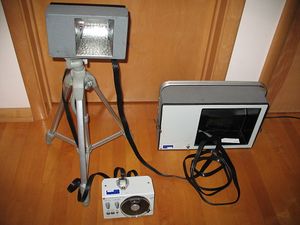Stroboscopics
Stroboscopics is a technique that uses a bright flashing light to induce visual hallucinations. The technique works by confusing optic nerve transmission which results in perceptual changes.
Mechanism of Action
The light emitted by the stroboscope (See Figure 1.), can be calibrated to flash at the same speed as the transmission rate of the optical nerve. This causes an temporary interference pattern which disorientates optical transmission to the brain leading to visual hallucinations similar to effects induced by psychedelic substances. It is thought that low hallucination-inducing frequencies range between 8 to 11 Hz, high hallucination-inducing frequencies range between 19 to 25 Hz[1] and 60 Hz has a similar effect to ketamine, enabling mature perineuronal nets disassembly in the brain[2].
Whilst the visual aspects of the psychedelic experience can be replicated, there is no evidence to suggest any other neurological effect occurs. The effects of stroboscopics can be readily demonstrated via experiment or from the comfort of one's home using Psychedelic Visualisation Modulators, the strongest of which is the stroboscopic tool.
References
- ↑ The hodology of hallucinations. FFYTCHE, D. (2008). Cortex, 44(8), 1067–1083. doi:10.1016/j.cortex.2008.04.005. Accessed on 17th September 2022 via: https://pubmed.ncbi.nlm.nih.gov/18586234/
- ↑ Microglia enable mature perineuronal nets disassembly upon anesthetic ketamine exposure or 60-Hz light entrainment in the healthy brain. Venturino A, Schulz R, De Jesús-Cortés H, et al. Cell Reports. 2021 Jul;36(1):109313. DOI: 10.1016/j.celrep.2021.109313. PMID: 34233180; PMCID: PMC8284881.
